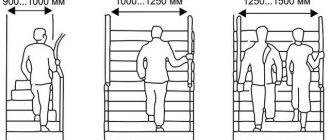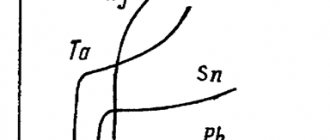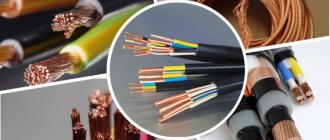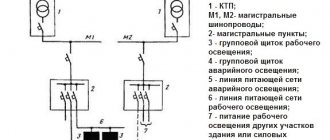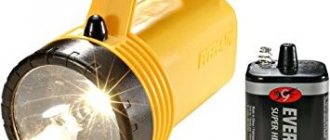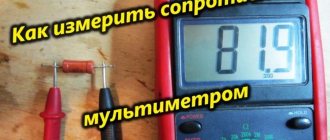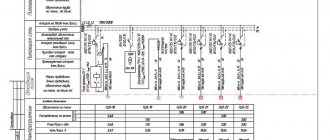TOEE CHPP RiEKT Metrology Real physics Superconductivity Theory of conductivity
|
Due to the fact that there are two types of electrical resistances -
ohmic resistance
- electrical resistance
to direct
current, determined by the friction created by the movement of electrical charge carriers in a conducting medium under the influence of a potential electric field in this medium (conductor).
active resistance
- electrical resistance
to alternating
current, determined by the friction created by the movement of electrical charge carriers in a conducting medium under the influence of potential and vortex electric fields in a conductor, conducting medium.
The following two basic concepts of resistivity should be distinguished.
- Specific electrical resistance to direct current
is the electrical resistance of a unit length of a conductor with a unit cross-sectional area [Ohm m], exerted to the movement of charge carriers in the conductor, as well as a semiconductor and ion-conducting solutions, under the influence of a potential electric field. Specific electrical resistance to direct current, on the one hand, is a derived concept from the electrical resistance of a conductor, and on the other, a basic concept of electrical materials science, since it determines the properties of the conductor material, regardless of its length and shape in general.
- Specific electrical resistance to alternating current
- this is the electrical resistance per unit length of a conductor of a unit area (for thin conductors) [Ohm m] / length of the cross-sectional surface (for thick conductors) [Ohm], exerted to the movement of charge carriers in the conductor, as well as the semiconductor and ion-conducting solutions, under the joint action potential and vortex electric field of a certain frequency. The specific electrical resistance to alternating current is always greater than the specific resistance to direct current due to the fact that a positive value is always added to the resistance to direct current - the resistance to the vortex movements of electric charge carriers in a conductor (and semiconductor). Specific electrical resistance to alternating current depends not only on the properties of the conductor material, but also on its shape, which determines the parameters of the vortex motion of electric charge carriers. The dimension of alternating current resistivity is different for thin and thick conductors. Thick conductors are considered to be conductors with a half-thickness greater than the depth of current penetration into the conductor.
In connection with the electromagnetic phenomena that arise in conductors when alternating current passes through them, two physical phenomena that are important for their electrical properties arise.
- Surface effect, skin effect
— attenuation of the electromagnetic field as it penetrates into the conducting medium. (see skin effect in physics, surface effect in electrical engineering)
- Proximity effect
- a decrease in current density in a wire due to the influence of currents in neighboring wires. (see surface effect and proximity effect in electrical engineering)
The last two phenomena make it ineffective to use conductors with a radius greater than the characteristic depth of penetration of electric current into the conductor. Effective diameter of conductors (2RBhar): 50Hz < 2.8mm for 400Hz < 1mm, 40kHz < 0.1mm. Therefore, at high frequencies, the use of only flat conductors and braids, multi-core cables (Litz wires) is effective.
Due to the high conductivity of metals, their resistance is measured with special devices - microohmmeters, today, as a rule, digital, having a lower resistance measurement limit of about 10-7 Ohms. Using microohmmeters, you can determine the quality of electrical contacts, the resistance of electrical busbars, windings of transformers, electric motors and generators, the presence of defects and foreign metal in ingots (for example, the resistance of a pure gold ingot is half that of a gold-plated tungsten ingot).
To calculate the length of the wire, its diameter and the required electrical resistance, it is necessary to know the resistivity of the conductors ρ.
In the international system of units, resistivity ρ is expressed by the formula:
ρ = Ohm mm2/m.
It means: the electrical resistance of 1 meter of wire (in Ohms), with a cross-section of 1 mm2, at a temperature of 20 degrees Celsius.
Conductor resistivity table
| Conductor material | Specific resistance ρ in |
| Silver Copper Gold Brass Aluminum Sodium Iridium Tungsten Zinc Molybdenum Nickel Bronze Iron Steel Tin Lead Nickelin (an alloy of copper, nickel and zinc) Manganin (an alloy of copper, nickel and manganese) Constantan (an alloy of copper, nickel and aluminum) Titanium Mercury Nichrome (an alloy of nickel, chromium, iron and manganese) Fechral Bismuth Chromal | 0,015 0,0175 0,023 0,025… 0,108 0,028 0,047 0,0474 0,05 0,054 0,059 0,087 0,095… 0,1 0,1 0,103… 0,137 0,12 0,22 0,42 0,43… 0,51 0,5 0,6 0,94 1,05… 1,4 1,15… 1,35 1,2 1,3… 1,5 |
The table shows that an iron wire with a length of 1 m and a cross-section of 1 mm2 has a resistance of 0.13 Ohm. To get 1 Ohm of resistance you need to take 7.7 m of such wire. Silver has the lowest resistivity. 1 Ohm of resistance can be obtained by taking 62.5 m of silver wire with a cross section of 1 mm2. Silver is the best conductor, but the cost of silver excludes the possibility of its mass use. After silver in the table comes copper: 1 m of copper wire with a cross-section of 1 mm2 has a resistance of 0.0175 Ohm. To get a resistance of 1 ohm, you need to take 57 m of such wire.
Chemically pure copper, obtained by refining, has found widespread use in electrical engineering for the manufacture of wires, cables, windings of electrical machines and devices. Aluminum and iron are also widely used as conductors.
The conductor resistance can be determined by the formula:
where r is the conductor resistance in ohms; ρ is the resistivity of the conductor; l is the length of the conductor in m; S - conductor cross-section in mm2.
Example 1. Determine the resistance of 200 m of iron wire with a cross section of 5 mm2.
Example 2. Calculate the resistance of 2 km of aluminum wire with a cross section of 2.5 mm2.
From the resistance formula you can easily determine the length, resistivity and cross-section of the conductor.
Example 3. For a radio receiver, it is necessary to wind a 30 Ohm resistance from nickel wire with a cross section of 0.21 mm2. Determine the required wire length.
Example 4. Determine the cross-section of 20 m of nichrome wire if its resistance is 25 Ohms.
Example 5. A wire with a cross section of 0.5 mm2 and a length of 40 m has a resistance of 16 Ohms. Determine the wire material.
The material of the conductor characterizes its resistivity.
Based on the resistivity table, we find that lead has this resistance.
It was stated above that the resistance of conductors depends on temperature. Let's do the following experiment. Let's wind several meters of thin metal wire in the form of a spiral and connect this spiral to the battery circuit. To measure current, we connect an ammeter to the circuit. When the coil is heated in the burner flame, you will notice that the ammeter readings will decrease. This shows that the resistance of a metal wire increases with heating.
For some metals, when heated by 100°, the resistance increases by 40 - 50%. There are alloys that change their resistance slightly with heating. Some special alloys show virtually no change in resistance when temperature changes. The resistance of metal conductors increases with increasing temperature, while the resistance of electrolytes (liquid conductors), coal and some solids, on the contrary, decreases.
The ability of metals to change their resistance with changes in temperature is used to construct resistance thermometers. This thermometer is a platinum wire wound on a mica frame. By placing a thermometer, for example, in a furnace and measuring the resistance of the platinum wire before and after heating, the temperature in the furnace can be determined.
temperature coefficient of resistance
- this is the change in the resistance of the conductor when it is heated, per 1 ohm of initial resistance and per 1° temperature, denoted by the letter α.
If at temperature t0 the resistance of the conductor is equal to r0, and at temperature t is equal to rt, then the temperature coefficient of resistance
Note. Calculation using this formula can only be done in a certain temperature range (up to approximately 200°C).
We present the values of the temperature coefficient of resistance α for some metals (Table 2).
table 2
Heating aluminum
Like other metals, the strength of aluminum decreases with increasing temperature. Up to some temperatures, this phenomenon is reversible, that is, after cooling, the material returns to the same properties as before heating. Up to a temperature of about 80 °C, the drop in strength can be neglected for all alloys and states. Above 80°C, some design situations may require consideration of the creep effect.
Figure 7 – Tensile strength of aluminum alloy 2014-T6 at different test temperatures [2]
Thermally strengthened alloys begin to lose strength at temperatures above 110 °C, and the extent of this phenomenon depends on the duration of heating.
Alloys that are not hardened by heat treatment begin to lose strength in cold-worked states at temperatures above 150 °C and also depending on the duration of heating. After heating non-thermally hardenable alloys in the annealed “O” state, no irreversible loss of strength occurs.
It is believed that short heating of thermally strengthened aluminum profiles to a temperature of 180-200 °C for 10-15 minutes, which occurs when powder paints are “melted,” does not lead to a serious loss of strength.
Temperature coefficient values for some metals
| Metal | α | Metal | α | |
| Silver Copper Iron Tungsten Platinum | 0,0035 0,0040 0,0066 0,0045 0,0032 | Mercury Nikelin Constantan Nichrome Manganin | 0,0090 0,0003 0,000005 0,00016 0,00005 |
From the formula for the temperature coefficient of resistance we determine rt:
rt = r0 [1 + α (t - t0)].
Example 6. Determine the resistance of an iron wire heated to 200°C, if its resistance at 0°C was 100 Ohms.
rt = r0 [1 + α (t - t0)] = 100 (1 + 0.0066 α 200) = 232 Ohm.
Example 7. A resistance thermometer made of platinum wire in a room with a temperature of 15°C had a resistance of 20 ohms. The thermometer was placed in the oven and after some time its resistance was measured. It turned out to be equal to 29.6 Ohms. Determine the temperature in the oven.
Electrical conductivity
So far, we have considered the resistance of a conductor as the obstacle that the conductor provides to the electric current. But still, current flows through the conductor. Therefore, in addition to resistance (obstacle), the conductor also has the ability to conduct electric current, that is, conductivity.
The more resistance a conductor has, the less conductivity it has, the worse it conducts electric current, and, conversely, the lower the resistance of a conductor, the more conductivity it has, the easier it is for current to pass through the conductor. Therefore, the resistance and conductivity of a conductor are reciprocal quantities.
From mathematics we know that the reciprocal of 5 is 1/5 and, conversely, the reciprocal of 1/7 is 7. Therefore, if the resistance of a conductor is denoted by the letter r, then the conductivity is defined as 1/r. Conductivity is usually symbolized by the letter g.
Electrical conductivity is measured in (1/Ohm) or in siemens.
Example 8. The conductor resistance is 20 ohms. Determine its conductivity.
If r = 20 Ohm, then
Example 9. The conductivity of the conductor is 0.1 (1/Ohm). Determine its resistance
If g = 0.1 (1/Ohm), then r = 1 / 0.1 = 10 (Ohm)
High conductivity materials
The most widespread materials of high conductivity include copper and aluminum (Superconducting materials, which have a typical resistance 10-20 times lower than ordinary conductive materials (metals), are discussed in the section Superconductivity).
Copper
The advantages of copper, which ensure its widespread use as a conductor material, are as follows:
- low resistivity;
- sufficiently high mechanical strength;
- corrosion resistance is satisfactory in most applications;
- good workability: copper is rolled into sheets, strips and drawn into wire, the thickness of which can be increased to thousandths of a millimeter;
- relative ease of soldering and welding.
Copper is most often obtained by processing sulfide ores. After a series of ore smelting and roasting with intense blasting, copper intended for electrical purposes must undergo a process of electrolytic purification.
Copper grades M1 and M0 are most often used as conductor material. M1 grade copper contains 99.9% Cu, and in the total amount of impurities (0.1%) oxygen should be no more than 0.08%. The presence of oxygen in copper worsens its mechanical properties. The best mechanical properties are found in M0 grade copper, which contains no more than 0.05% impurities, including no more than 0.02% oxygen.
Copper is a relatively expensive and scarce material, so it is increasingly being replaced by other metals, especially aluminum.
In some cases, alloys of copper with tin, silicon, phosphorus, beryllium, chromium, magnesium, and cadmium are used. Such alloys, called bronzes, with the correct composition, have significantly higher mechanical properties than pure copper.
Aluminum
Aluminum is the second most important conductor material after copper. This is the most important representative of the so-called light metals: the density of cast aluminum is about 2.6, and rolled aluminum is 2.7 Mg/m3. Thus, aluminum is approximately 3.5 times lighter than copper. The temperature coefficient of expansion, specific heat capacity and heat of fusion of aluminum are greater than those of copper. Due to the high values of specific heat capacity and heat of fusion, heating aluminum to the melting point and transferring it to a molten state requires more heat than heating and melting the same amount of copper, although the melting point of aluminum is lower than that of copper.
Aluminum has lower properties compared to copper - both mechanical and electrical. With the same cross-section and length, the electrical resistance of an aluminum wire is 1.63 times greater than that of a copper wire. It is very important that aluminum is less scarce than copper.
For electrical purposes, aluminum containing no more than 0.5% impurities, grade A1, is used. Even purer AB00 grade aluminum (no more than 0.03% impurities) is used for the manufacture of aluminum foil, electrodes and housings of electrolytic capacitors. Aluminum of the highest purity AB0000 has an impurity content of no more than 0.004%. Additives of Ni, Si, Zn or Fe at a content of 0.5% reduce the γ of annealed aluminum by no more than 2-3%. A more noticeable effect is exerted by Cu, Ag and Mg impurities, which, at the same mass content, reduce γ aluminum by 5-10%. Ti and Mn greatly reduce the electrical conductivity of aluminum.
Aluminum oxidizes very actively and becomes covered with a thin oxide film with high electrical resistance. This film protects the metal from further corrosion.
Aluminum alloys have increased mechanical strength. An example of such an alloy is Aldrey , containing 0.3-0.5% Mg, 0.4-0.7% Si and 0.2-0.3% Fe. In aldrey, the Mg2Si compound is formed, which imparts high mechanical properties to the alloy.
Iron and steel
Iron (steel), as the cheapest and most accessible metal, which also has high mechanical strength, is of great interest for use as a conductor material. However, even pure iron has a significantly higher resistivity compared to copper and aluminum; ρ steel, i.e. iron mixed with carbon and other elements is even higher. Ordinary steel has low corrosion resistance: even at normal temperatures, especially in conditions of high humidity, it quickly rusts; As the temperature rises, the corrosion rate increases sharply. Therefore, the surface of steel wires must be protected by a layer of more resistant material. Zinc coating is usually used for this purpose.
In some cases, to reduce the consumption of non-ferrous metals, the so-called bimetal . It is steel coated on the outside with a layer of copper, with both metals connected to each other firmly and continuously.
Sodium
Sodium metal is a very promising conductor material. Sodium can be obtained by electrolysis of molten sodium chloride NaCl in virtually unlimited quantities. From a comparison of the properties of sodium with the properties of other conductor metals, it is clear that the resistivity of sodium is approximately 2.8 times greater than ρ of copper and 1.7 times greater than ρ of aluminum, but due to the extremely low density of sodium (its density is almost 9 times less than the density of copper), a wire made of sodium for a given conductivity per unit length should be significantly lighter than a wire made of any other metal. However, sodium is extremely active chemically (it oxidizes intensely in air and reacts violently with water), which is why the sodium wire must be protected with a sealing sheath. The sheath must give the wire the necessary mechanical strength, since sodium is very soft and has a low tensile strength during deformation.
Literature on conductor resistivity
- Kuznetsov M.I., “Fundamentals of Electrical Engineering” - 9th edition, revised - Moscow: Higher School, 1964 - 560 p.
- Bachelis D. S., Belorussov N. I., Saakyan A. E. Electrical cables, wires and cords. Directory. - M.: Energy, 1971.
- Gershun A.L. Cable // Encyclopedic Dictionary of Brockhaus and Efron: in 86 volumes (82 volumes and 4 additional). - St. Petersburg, 1890-1907.
- R. Lakernik, D. Charlet. From copper to glass // Science and life. - 1986. - Issue. 08. - pp. 50-54, 2-3 pages, color insert.
TOEE CHPP RiEKT Metrology Real physics Superconductivity Theory of conductivity
Thermal expansion of aluminum
The linear thermal expansion of aluminum and its alloys is 24·10-6 per 1 degree Celsius - twice as much as that of steels. This must be taken into account in many designs in which it is necessary to ensure free thermal expansion of elements. When thermal expansion (or contraction) is limited in an aluminum element, due to the lower modulus of elasticity, stresses arise that are 2/3 of the stresses that would arise in a similar steel element.
